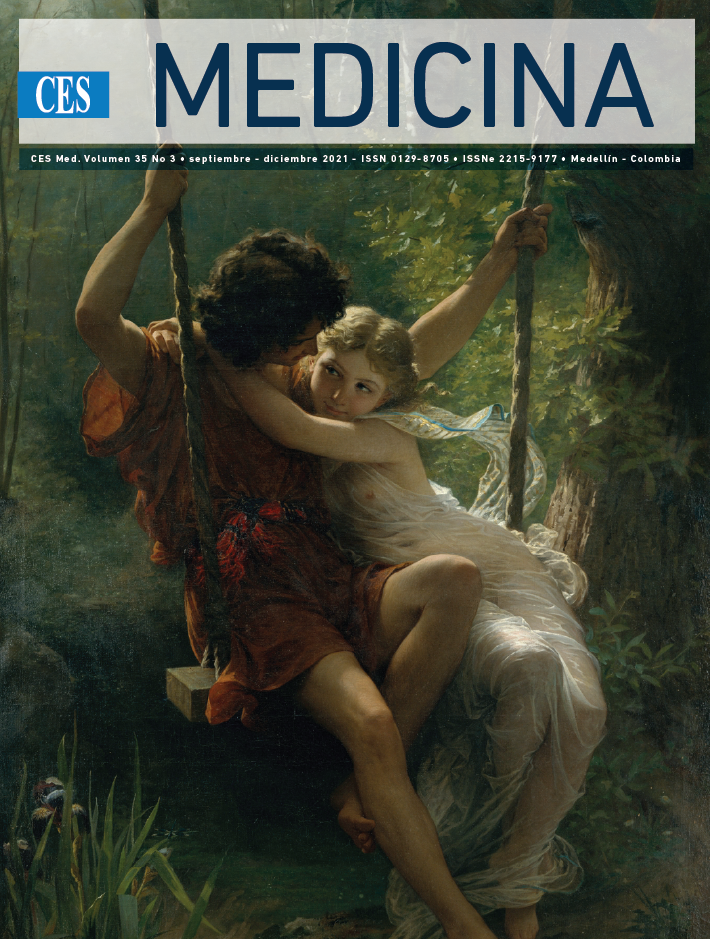Factores pronósticos que afectan la supervivencia en el paciente con mieloma múltiple
DOI:
https://doi.org/10.21615/cesmedicina.6278Palabras clave:
mieloma múltiple, pronóstico, supervivencia, factores de riesgoResumen
El mieloma múltiple es la segunda neoplasia hematológica más frecuente y se caracteriza por la expansión aberrante de las células plasmáticas monoclonales, en la mayoría de los casos con la producción de una paraproteína anormal conocida como proteína monoclonal o por evidencia de daño orgánico, manifestado por hipercalcemia, insuficiencia renal, anemia o lesiones óseas. Los factores pronósticos han evolucionado desde la caracterización de la carga tumoral utilizando el sistema de estadificación Durie y Salmon y el sistema de estadificación internacional, hasta el análisis molecular y el perfil de expresión génica, debido al reconocimiento de aberraciones cromosómicas y moleculares que desempeñan un papel en el desarrollo del mieloma múltiple y la progresión del mismo. El sistema de estadificación internacional se revisó en 2015 agregando anormalidades genéticas de alto riesgo, tales como la presencia de mutaciones t(4;14), t(14;16) y del(17p) junto con la adición de la deshidrogenasa láctica. Es así como, a lo largo del tiempo, se han identificado factores pronósticos importantes de esta neoplasia que se encuentran asociados al huésped y al microambiente tumoral, además de variables clínicas y anormalidades de las células tumorales.
Descargas
Referencias bibliográficas
Zweegman S, Palumbo A, Bringhen S, Sonneveld P. Age and aging in blood disorders: Multiple myeloma. Haematologica. 2014; 99(7): 1133–37. doi: 10.3324/haematol.2014.110296.
Rajkumar SV. Multiple myeloma: 2016 update on diagnosis, risk-stratification, and management. Am J Hematol. 2016;91(7):719-34. doi: 10.1002/ajh.24402.
Brigle K, Rogers B. Pathobiology and Diagnosis of Multiple Myeloma. Seminars in Oncology Nursing. 2017;33(3)225-36. doi: https://doi.org/10.1016/j.soncn.2017.05.012.
Palumbo A, Avet-Loiseau H, Oliva S, Lokhorst HM, Goldschmidt H, Rosinol L, et al. Revised international staging system for multiple myeloma: A report from international myeloma working group. J Clin Oncol. 2015;33(26):2863-9. doi: 10.1200/JCO.2015.61.2267.
Biran N, Jagannath S, Chari A. Risk Stratification in Multiple Myeloma, Part 1: Characterization of High-Risk Disease. Clin Adv Hematol Oncol. 2013;11(8):489-503.
Smith BD, Smith GL, Hurria A, Hortobagyi GN, Buchholz TA. Future of cancer incidence in the United States: Burdens upon an aging, changing nation. J Clin Oncol. 2009;27(17):2758-65. doi: 10.1200/JCO.2008.20.8983.
Bila J, Jelicic J, Djurasinovic V, Vukovic V, Sretenovic A, Andjelic B, et al. Prognostic effect of comorbidity indices in elderly patients with multiple myeloma. Clin Lymphoma, Myeloma Leuk. 2015;15(7):416-9. doi: https://doi.org/10.1016/j.clml.2015.03.004.
Palumbo A, Bringhen S, Ludwig H, Dimopoulos MA, Bladé J, Mateos M V., et al. Personalized therapy in multiple myeloma according to patient age and vulnerability: A report of the European Myeloma Network (EMN). Blood. 2011;118 (17): 4519–4529. doi: https://doi.org/10.1182/blood-2011-06-358812.
Waxman AJ, Mink PJ, Devesa SS, Anderson WF, Weiss BM, Kristinsson SY, et al. Racial disparities in incidence and outcome in multiple myeloma: A population-based study. Blood. 2010;116(25):5501-6. doi: 10.1182/blood-2010-07-298760.
Boyd KD, Ross FM, Chiecchio L, Dagrada GP, Konn ZJ, Tapper WJ, et al. Gender disparities in the tumor genetics and clinical outcome of multiple myeloma. Cancer Epidemiol Biomarkers Prev. 2011;20(8):1703-7. doi: 10.1158/1055-9965.EPI-11-0157.
Myeloma — Cancer Stat Facts [Internet]. [citado 20 de mayo de 2020]. Disponible en: https://seer.cancer.gov/statfacts/html/mulmy.html
Lemaire M, Deleu S, De Bruyne E, Van Valckenborgh E, Menu E, Vanderkerken K. The Microenvironment and Molecular Biology of the Multiple Myeloma Tumor. Adv Cancer Res. 2011; 110:19-42. doi: 10.1016/B978-0-12-386469-7.00002-5.
Bieghs L, Johnsen HE, Maes K, Menu E, Van Valckenborgh E, Overgaard MT, et al. The insulin-like growth factor system in Multiple Myeloma: Diagnostic and therapeutic potential. Oncotarget. 2016; 7(30): 48732–52. doi: 10.18632/oncotarget.8982.
Hakuno F, Takahashi SI. 40 YEARS OF IGF1: IGF1 receptor signaling pathways. Journal of Molecular Endocrinology. 2018;61(1): 69-86. doi: https://doi.org/10.1530/JME-17-0311.
Descamps G, Wuillème-Toumi S, Trichet V, Venot C, Debussche L, Hercend T, et al. CD45 neg but Not CD45 pos Human Myeloma Cells Are Sensitive to the Inhibition of IGF-1 Signaling by a Murine Anti-IGF-1R Monoclonal Antibody, mAVE1642 . J Immunol. 15 de septiembre de 2006;177(6):4218-23. doi: https://doi.org/10.4049/jimmunol.177.6.4218.
Côté S, Lemieux R, Simard C. The survival of IL-6-dependent myeloma cells critically relies on their capability to transit the G1 to S phase interval of the cell cycle. Cell Signal. 2005;17(5):615-24. https://doi.org/10.1016/j.cellsig.2004.10.004.
Lauta VM. A review of the cytokine network in multiple myeloma: diagnostic, prognostic, and therapeutic implications. Cancer. 2003;97(10):2440‐2452. doi: 10.1002/cncr.11072.
Finkel KW, Cohen EP, Shirali A, Abudayyeh A. Paraprotein-related kidney disease: Evaluation and treatment of myeloma cast nephropathy. Clin J Am Soc Nephrol. 2016;11(12):2273-9. doi: https://doi.org/10.2215/CJN.01640216.
Eleutherakis-Papaiakovou V, Bamias A, Gika D, et al. Renal failure in multiple myeloma: incidence, correlations, and prognostic significance. Leuk Lymphoma. 2007;48(2):337‐341. doi: 10.1080/10428190601126602.
Gonsalves WI, Leung N, Rajkumar SV, et al. Improvement in renal function and its impact on survival in patients with newly diagnosed multiple myeloma. Blood Cancer J. 2015;5(3):e296. doi: 10.1038/bcj.2015.20
Peña C, Valladares X, Gajardo C, Russo M, Morales Á, Correa G, et al. Prognostic impact of renal failure recovery in patients with newly diagnosed multiple myeloma. rev Med chile. 2019, 147(11):1374-81. doi: 10.4067/s0034-98872019001101374.
Lee SY, Kim HJ, Shin YR, Park HJ, Lee YG, Oh SJ. Prognostic significance of focal lesions and diffuse infiltration on MRI for multiple myeloma: a meta-analysis. Eur Radiol. 2017;27(6):2333‐47. doi: 10.1007/s00330-016-4543-8.
Moulopoulos LA, Gika D, Dellasale K, Weber D, Anagnostopoulos A, Alexanian R, et al. Prognostic Significance of Magnetic Resonance Imaging (MRI) of Bone Marrow in Previously Untreated Patients with Multiple Myeloma. Blood. 2004;104(11):1485-85. doi: https://doi.org/10.1182/blood.V104.11.1485.1485.
Rasche L, Angtuaco EJ, Alpe TL, Gershner GH, McDonald JE, Samant RS, et al. The presence of large focal lesions is a strong independent prognostic factor in multiple myeloma. Blood. 2018;132(1):59‐66. doi: 10.1182/blood-2018-04-842880.
Kim JE, Yoo C, Lee DH, Kim SW, Lee JS, Suh C. Serum albumin level is a significant prognostic factor reflecting disease severity in symptomatic multiple myeloma. Ann Hematol. 2010;89(4):391‐397. doi: 10.1007/s00277-009-0841-4.
Rodríguez L, Rivera C, Arencibia A, Avila O, Izquierdo L, Espinosa E, et al. Caracterización clínica y de laboratorio del mieloma múltiple en el Instituto de Hematología e Inmunología. Rev Cuba Hematol Inmunol y Hemoter.2013;29(4):382-97.
Dimopoulos MA, Kastritis E, Michalis E, Tsatalas C, Michael M, Pouli A, et al. TheInternational Scoring System (ISS) for multiple myeloma remains a robust prognostic tool independently of patients’ renal function. Annals of Oncology. 2012;23(3):722-9. doi: https://doi.org/10.1093/annonc/mdr276.
Alexanian R, Barlogie B, Dixon D. Renal Failure in Multiple Myeloma. Pathogenesis and prognostic implications. Arch Intern Med. 1990;150(8):1693-5. doi: 10.1001/archinte.1990.00040031693017.
Gu Y, Yuan YH, Xu J, Shi QL, Qu XY, Guo R, et al. High serum lactate dehydrogenase predicts an unfavorable outcome in Chinese elderly patients with multiple myeloma. Oncotarget. 2017;8(29):48350‐48361. doi: 10.18632/oncotarget.16237.
Lopes M, Higashi F, Cury P, de Queiroz Crusoé E, Hungria V, Cançado RD, et al. The impact of lactate dehydrogenase (LDH) in association with the International Staging System (ISS) on patients with multiple myeloma. Clin Lymphoma Myeloma Leuk. 2019;19(10):e93. doi: 10.1016/j.clml.2019.09.151.
Meddour Y, Cherif Rahali M, Eddine Belakehal S, Benfenatki N, Zohra Ardjoune F, Chaib S, et al. Plasma cell immunophenotyping improve prognostic stratification of multiple myeloma patients. Int J Cancer Manag. 2018;11(1). doi : 10.5812/ijcm.5350.
Paiva B, Almeida J, Pérez M, Gema M, López A, Basillo A, et al. Utility of flow cytometry immunophenotyping in multiple myeloma and other clonal plasma cell-related disorders. Cytometry B Clin Cytom. 2010;78(4):239‐52. doi: 10.1002/cyto.b.20512.
Neben K, Jauch A, Bertsch U, Heiss C, Hielscher T, Seckinger A, et al. Combining information regarding chromosomal aberrations t(4;14) and del(17pl3) with the international staging system classification allows stratification of myeloma patients undergoing autologous stem cell transplantation. Haematologica. 2010;95(7):1150-7. doi: 10.3324/haematol.2009.016436.
Zhuang J, Da Y, Li H, Han B, Wan X, Zhu T, et al. Cytogenetic and clinical risk factors for assessment of ultra high-risk multiple myeloma. Leuk Res. 2014;38(2):188‐193. doi: 10.1016/j.leukres.2013.11.010.
Hervé A, Florent M, Loic C, Magrangeas F, Sebban C, Lioure B, et al. Translocation t(14;16) and multiple myeloma: is it really an independent prognostic factor?. Blood. 2011;117(6):2009‐2011. doi: 10.1182/blood-2010-07-295105.
Descargas
Publicado
Cómo citar
Número
Sección
Licencia
Derechos de autor 2021 CES Medicina

Esta obra está bajo una licencia internacional Creative Commons Atribución-NoComercial-CompartirIgual 4.0.
Derechos de reproducción (copyright)
Cada manuscrito se acompañará de una declaración en la que se especifique que los materiales son inéditos, que no han sido publicados anteriormente en formato impreso o electrónico y que no se presentarán a ningún otro medio antes de conocer la decisión de la revista. En todo caso, cualquier publicación anterior, sea en forma impresa o electrónica, deberá darse a conocer a la redacción por escrito.
Plagios, duplicaciones totales o parciales, traduccones del original a otro idioma son de responsabilidad exclusiva de los autores el envío.
Los autores adjuntarán una declaración firmada indicando que, si el manuscrito se acepta para su publicación, los derechos de reproducción son propiedad exclusiva de la Revista CES Medicina.
Se solicita a los autores que proporcionen la información completa acerca de cualquier beca o subvención recibida de una entidad comercial u otro grupo con intereses privados, u otro organismo, para costear parcial o totalmente el trabajo en que se basa el artículo.
Los autores tienen la responsabilidad de obtener los permisos necesarios para reproducir cualquier material protegido por derechos de reproducción. El manuscrito se acompañará de la carta original que otorgue ese permiso y en ella debe especificarse con exactitud el número del cuadro o figura o el texto exacto que se citará y cómo se usará, así como la referencia bibliográfica completa.
| Estadísticas de artículo | |
|---|---|
| Vistas de resúmenes | |
| Vistas de PDF | |
| Descargas de PDF | |
| Vistas de HTML | |
| Otras vistas | |



